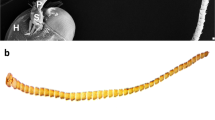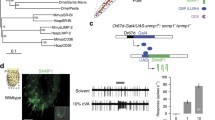Summary
Phospholipase C in the antennae of Periplaneta americana was stimulated by pheromones in a GTP-dependent manner. The enzyme activity was potentiated by hydrolysis-resistant analogs of GTP and decreased by GDP analogs. Guanine nucleotide binding regulatory proteins (G-proteins) in antennal preparations were identified by bacterial toxin-catalyzed ADP-ribosylation and immunoreactivity with antibodies of designed specificity. The stimulatory effect of pheromones on inositol phosphate formation was completely blocked by pertussis toxin suggesting that the pheromone action was mediated via specific G-proteins.
Similar content being viewed by others
Abbreviations
- G-protein :
-
guanine nucleotide-binding regulatory protein
- IP 3 :
-
inositol 1,4,5-trisphosphate
- GTPS :
-
guanine-5′-[thio]-triphosphate
- GDPβS :
-
guanine-5′-[β-thio]-diphosphate
- NAD :
-
nicotinic acid adenine dinucleotide
- SDS-PAGE :
-
sodium dodecylsulfate polyacrylamide gel electrophoresis
- DTT :
-
dithiothreitol
- MOPS :
-
3-(N-morpholino)propanesulfonic acid
- PIPES :
-
piperazine-N,N′-bis[2-ethanesulfonic acid]
- DMSO :
-
dimethyl-sulfoxide
References
Berridge MJ (1984) Inositol trisphosphate and diacylglycerol as second messengers. Biochem J 220: 345–360
Boeckh J, Kaissling KE, Schneider D (1965) Insect olfactors receptors. Cold Spring Harbor Symp. Quant Biol 30: 263–280
Boekhoff I, Strotmann J, Raming K, Tareilus E, Breer H (in press) Odorant-sensitive phospholipase C in insect antennae. Cellul Signalling
Bradford MM (1976) A rapid and sensitive method for quantitation of microgram quantities of protein utilizing the principle of protein-dye binding. Anal Biochem 65: 248–254
Bradford PG, Rubin RP (1985) Pertussis toxin inhibits chemotactic factor-induced phospholipase C stimulation and lysosomal enzyme secretion in rabbit neutrophils. FEBS Lett 183: 317–320
Breer H, Raming K, Boekhoff I (1988) G-proteins in the antennae of insects. Naturwissenschaften 75: 627
Breer H, Boekhoff I, Strotmann J, Raming K, Tareilus E (1989) Molecular elements of olfactory signal transduction in insect antennae. In: Schild D (ed) Information processing of chemical sensory stimuli in biological and artificial systems. Springer, Berlin Heidelberg New York, pp 77–86
Cassel D, Lefkovitz H, Selinger Z (1977) The regulatory GTPase cycle of turkey erythrocyte adenylate cyclase. J Cyclic Nucleotide Res 3: 393–397
Challis RAJ, Batty IH, Nahorski SR (1988) Mass measurements of inositol (1,4,5) trisphosphate in rat cerebral cortex slices using a radioreceptor assay: effects of neurotransmitters and depolarization. Biochem Biophys Res Comm 157: 684–691
Cockroft S (1987) Polyphosphoinositide phosphodiesterase: regulation by a novel guanine nucleotide binding protein, Gp. Trends Biochem Sci 12: 75–78
Cockeroft S, Gomperts BD (1985) Role of guanine nucleotide binding protein in the activation of polyphosphoinositide phosphodiesterase. Nature, Lond 314: 534–536
Dohlman HG, Caron MG, Lefkowitz RJ (1987) A family of receptors coupled to guanine nucleotide regulatory proteins. Biochem 26: 2657–2664
Eckstein PD, Cassel D, Levkovitz H, Lowe M, Selinger Z (1979) Guanosine 5′ 0-(2-thiodiphosphate): An inhibitor of adenylate cyclase stimulation by guanine nucleotides and fluoride ions. J Biol Chem 254: 9829–9836
Gilman AG (1987) G-proteins: transducers of receptor-generated signals. Ann Rev Biochem 56: 615–649
Kaissling KE (1986) Chemo-electrical transduction in insect olfactory receptors. Ann Rev Neurosci 9: 121–145
Lancet D, Pace U (1987) The molecular basis of odor recognition. Trends Biochem Sci 12: 63–66
Mumby SM, Kahn RA, Manning DR, Lancet D (1986) Antisera of designed specificity for subunits of guanine nucleotide binding regulatory proteins. Proc Natl Acad Sci USA 83: 265–269
Novoselov VI, Krapivinskaya LD, Krapivinsky GB, Fesenko EE (1988) GTP-binding protein associated with amino acid binding proteins from olfactory epithelium of skate Dasyatis pastinaca. FEBS Lett 234: 471–474
Martin TFJ, Lucas DO, Bajjalieh SM, Kowalchyk JA (1986) Thyrotropin-releasing hormone activates a Ca2+-dependent polyphosphoinositide phosphodiesterase in permeable GH3 cells. J Biol Chem 261: 2918–2927
Pace U, Hanski E, Salomon Y, Lancet D (1985) Odorant-sensitive adenylate cyclase may mediate olfactory reception. Nature, Lond 316: 255–258
Pace U, Lancet D (1986) Olfactory GTP-binding protein: signaltransducing polypeptide of vertebrate chemosensory neurons. Proc Natl Acad Sci USA 83: 4947–4951
Palmer S, Hughes KT, Lee DY, Wakelam MJO (1989) Development of a novel, Ins (1,4,5) P3-specific binding assay. Its use to determine the intracellular concentration of Ins (1,4,5) P3 in unstimulated and vasopressin-stimulated rat hepatocytes. Cellul Signal 1: 147–156
Rhee SG, Suh PG, Ryu SH, Lee SY (1989) Studies of inositol phospholipid-specific phospholipase C. Science 244: 546–550
Ribeiro-Neto FAP, Mattera R, Hildebrandt J, Codina JB, Field JB, Birnbaumer L, Sekura RD (1985) ADP-ribosylation of membrane components by pertussis and cholera toxin. Meth Enzymol 109: 566–571
Sklar PB, Anholt RR, Snyder SH (1986) The odorant-sensitive adenylate cyclase of olfactory receptor cells. J Biol Chem 261: 15538–15543
Stryer L (1986) Cyclic GMP cascade of vision. Ann Rev Neurosci 9: 87–119
Stryer L, Bourne HR (1986) G-proteins: a family of signal transducers. Ann Rev Cell Biol 2: 391–419
Ui M, Katada T, Murayama T, Kurose H, Yajima M (1984) Isletactivating protein, pertussis toxin: A specific uncoupler of receptor-mediated inhibition of adenylate cyclase. Adv Cyclic Nucleotide Res 17: 145–151
Vogt RG, Prestwich GD, Riddiford LM (1988) Sex pheromone receptor proteins. Visualization using a radiolabelled photoaffinity analog. J Biol Chem 263: 3952–3959
Author information
Authors and Affiliations
Rights and permissions
About this article
Cite this article
Boekhoff, I., Raming, K. & Breer, H. Pheromone-induced stimulation of inositol-trisphosphate formation in insect antennae is mediated by G-proteins. J Comp Physiol B 160, 99–103 (1990). https://doi.org/10.1007/BF00258768
Accepted:
Issue Date:
DOI: https://doi.org/10.1007/BF00258768




